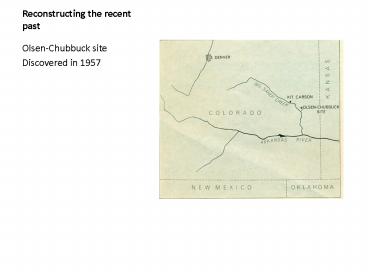Reconstructing the recent past - PowerPoint PPT Presentation
1 / 16
Title:
Reconstructing the recent past
Description:
Top layer: individual bones and partially articulated bones in similar piles. ... Mammoth hunters: Clovis points. ca. 7,000 years ago. E Colorado: Scottsbluff points ... – PowerPoint PPT presentation
Number of Views:21
Avg rating:3.0/5.0
Title: Reconstructing the recent past
1
Reconstructing the recent past
- Olsen-Chubbuck site
- Discovered in 1957
2
Cross-section of arroyo
- Long-buried by wind-borne deposits.
3
Part of the excavated arroyo.
- Ancient arroyo 170 feet long
- Remains of 193 bison
- Bison occidentalis
- not Bison bison
- Bones in three layers
- Bottom complete skeletons of 13 individual
bison. - Middle bones of partially butchered individuals
- Top layer individual bones and partially
articulated bones in similar piles. - Dated at 8,500 ybp
- Holocene epoch
4
Projectile points associated with the bison bones.
Material culture
5
- The reconstruction of events
- 1. Time of year.
- 2. Wind direction
- 3. The stampede.
6
- 75 of the bison were completely burchered.
- Based on numbers of mature bulls, immature
bulls, mature cows, immature cows, and calves - The butchered bison estimated to have produiced
- 56,640 pounds of fresh meat
- 4,000 pounds of edible internal organs
- 5,400 pounds of fat.
- 100 people could have completed the butchering in
half a day. - Enough meat, internal organs, and fat to feed a
group of 150 for 23 days.
7
- Example of Prehistoric cultural evolution
- e.g. projectile points
- Stone industry
- traditions
- ca. 11,200 years ago
- Dent site - 43 miles NE of Denver
- Mammoth hunters Clovis points
- ca. 7,000 years ago
- E Colorado Scottsbluff points
- SE New Mexico Plainview points
- Bison hunters
8
Plainview point Clovis point
9
Humans
- Humans have
- 1. an evolutionary history phylogeny
- All heritable changes that have brought humans
to present form - Biological evolution is not progressive
- e.g., not always simple to complex
- 2. an individual life history ontogeny
- Phenotypic expression of traits attributes
- Based on genetic and environment factors
10
Effects of isolation on diversity
11
Two Basic Ways of explaining natural phenomena
- 1. Supernatural explanations for natural
phenomena - Cannot be tested (proved or disproved)
- Accepted on faith.
- Superstitions, myths, religions, philosophies
- Used to define ways of operating
- ethics, morals, laws
- Belief systems
- hold groups of individuals together and keep
groups of individuals apart. - enhance the psychological well-being of
individuals. - Provide hope and purpose
- Affect the way individuals behave toward one
another - Individuals have to be indoctrinated.the beliefs
are passed from one generation to the next by
teaching and learning
12
Ca. 42,000 religions
13
- 2. Scientific explanations
- Science a process for the acquisition of
information about the natural world - Gotten through our senses (empiricism).
- Observations and experiments are repeatable
- Facts are supported by evidence.
- E.g., skull
- Does it represent a biped?
14
- Scientific investigations
- Evidence is used to test hypotheses
- Hypothesis a testable tentative explanation for
a phenomenon. - Null hypothesis (Ho)
- Alternative hypotheses (H1)
- Approach collect data (evidence) and attempt to
reject (refute, falsify) the Ho. - Bias is removed by attempting to reject
hypotheses. They cant be proven.
15
- Accumulations of verifiable facts lead to
- discovery of fundamental truths theories
- Theory means something different to different
groups of people. - Science willing to modify conclusions if new
evidence falsifies previous evidence.
16
Cultural vs. biological evolution
- Culture non-biological adaptations
- Sum total of learned traditions, beliefs, and
values used by a particular society. - Transmission between generations is non-genetic
teaching - Cultural evolution is progressive
- Predictable, sequential improvements can be made
through time.






![❤[READ]❤ The Archaeology of Utopian and Intentional Communities (American Experience in PowerPoint PPT Presentation](https://s3.amazonaws.com/images.powershow.com/10050442.th0.jpg?_=20240607121)
























